Rick Just's Blog, page 151
September 8, 2020
Is this History Rigged??
What’s worthy of getting you a place in Idaho History? Introducing quail to Idaho might do the trick. Henry Chiles Riggs did that in 1871, bringing 56 birds from Missouri. That would be just a footnote, clear down at the bottom of the page in a history book that had little else to talk about.
Okay, how about claiming to be the first citizen of Boise? There were a couple of cabins built where Boise would be, but they were unoccupied, according to Riggs. He claimed that first person honor by pitching a tent and living in it. So, history.
Riggs might have a better chance of making it in print if he brought the first newspaper to Boise, which he did. He didn’t start the Idaho Statesmen, but he went to Portland in 1864 and found some folks who were willing to establish a newspaper in the new town which, by the way, had been named Boise by Henry C. Riggs. Solid footing on the historical footnotes, now.
Riggs was elected to the first Idaho Territorial Legislature from Boise County. He didn’t do a lot in Lewiston during that first session. He just introduced a bill to move the territorial capital to Boise and was instrumental in another one to split Boise County in two. Both passed. Oh, and he suggested the name for the new county. It would be called Ada County, named for his daughter Ada Riggs.
He spent most of his later life at a ranch he bought near Payette. Henry Chiles Riggs died on July 3, 1909, at the Old Soldiers Home in Boise, his place in Idaho history assured.
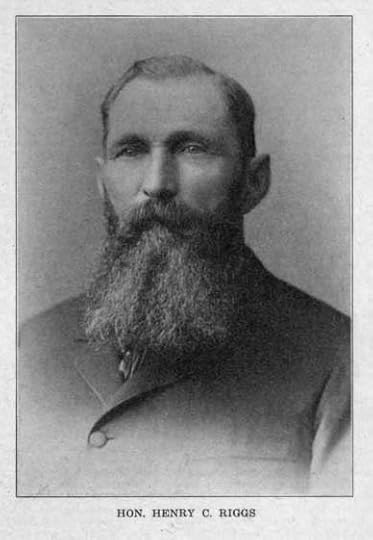
Okay, how about claiming to be the first citizen of Boise? There were a couple of cabins built where Boise would be, but they were unoccupied, according to Riggs. He claimed that first person honor by pitching a tent and living in it. So, history.
Riggs might have a better chance of making it in print if he brought the first newspaper to Boise, which he did. He didn’t start the Idaho Statesmen, but he went to Portland in 1864 and found some folks who were willing to establish a newspaper in the new town which, by the way, had been named Boise by Henry C. Riggs. Solid footing on the historical footnotes, now.
Riggs was elected to the first Idaho Territorial Legislature from Boise County. He didn’t do a lot in Lewiston during that first session. He just introduced a bill to move the territorial capital to Boise and was instrumental in another one to split Boise County in two. Both passed. Oh, and he suggested the name for the new county. It would be called Ada County, named for his daughter Ada Riggs.
He spent most of his later life at a ranch he bought near Payette. Henry Chiles Riggs died on July 3, 1909, at the Old Soldiers Home in Boise, his place in Idaho history assured.

Published on September 08, 2020 04:00
September 7, 2020
Naming Gowen Field
At first, military officials didn’t think the air base near Boise could be named at all, because it was leased property not owned by the military. A new interpretation of regulations set those concerns aside, and in June of 1941 the Field Naming Board in Washington, D.C. began deliberating.
There were three names under consideration, each to potentially honor Air Corps members from Idaho who had lost their lives. They were Col. Lawrence F. Stone, who was killed may 25, 1940; First Lt. Paul R. Gowen, who was killed July 11 1938; and Second Lt. R. W. Merrick, who was killed Nov. 20, 1932.
Speculation at the time was that it would be named Stone Field, because he was the highest-ranking officer of the three under consideration.
When the Field Naming Board announced their selection, it was Lt. Gowen who was honored. Gowen was a native of Caldwell who had spent two years at the University of Idaho before transferring to the Military Academy a West Point in 1929. He was a Rhodes Scholar candidate and once applied for a patent for a fuel consumption indicator. The patent was awarded after his death.
Gowen was a flight instructor who had one aerial brush with death in Louisiana in 1937. He and a student were flying a BT-2 Army Trainer when a dust storm kicked up. They circled looking for a place to land without success. When their fuel ran out Gowen ordered his student to parachute from the plane. The student jumped and Gowen followed. Neither was hurt.
It was a dead engine in a twin-engine B-10B that cost Gowen his life. He tried to bring the damaged airplane back to Albrook Field in the Panama Canal Zone but couldn’t keep it in the air long enough. The plane crashed into the jungle, killing Lt. Gowen. Two passengers were injured, but survived. Lt. Paul R. Gowen was buried with full military honors at the Canyon Hill Cemetery in Caldwell. He was 29.
The military Gowen Field was officially named in 1941. In September of 1970, the Boise Air Terminal also officially adopted the name. Lt. Paul R. Gowen, for whom Gowen field was named.
Lt. Paul R. Gowen, for whom Gowen field was named.
There were three names under consideration, each to potentially honor Air Corps members from Idaho who had lost their lives. They were Col. Lawrence F. Stone, who was killed may 25, 1940; First Lt. Paul R. Gowen, who was killed July 11 1938; and Second Lt. R. W. Merrick, who was killed Nov. 20, 1932.
Speculation at the time was that it would be named Stone Field, because he was the highest-ranking officer of the three under consideration.
When the Field Naming Board announced their selection, it was Lt. Gowen who was honored. Gowen was a native of Caldwell who had spent two years at the University of Idaho before transferring to the Military Academy a West Point in 1929. He was a Rhodes Scholar candidate and once applied for a patent for a fuel consumption indicator. The patent was awarded after his death.
Gowen was a flight instructor who had one aerial brush with death in Louisiana in 1937. He and a student were flying a BT-2 Army Trainer when a dust storm kicked up. They circled looking for a place to land without success. When their fuel ran out Gowen ordered his student to parachute from the plane. The student jumped and Gowen followed. Neither was hurt.
It was a dead engine in a twin-engine B-10B that cost Gowen his life. He tried to bring the damaged airplane back to Albrook Field in the Panama Canal Zone but couldn’t keep it in the air long enough. The plane crashed into the jungle, killing Lt. Gowen. Two passengers were injured, but survived. Lt. Paul R. Gowen was buried with full military honors at the Canyon Hill Cemetery in Caldwell. He was 29.
The military Gowen Field was officially named in 1941. In September of 1970, the Boise Air Terminal also officially adopted the name.
 Lt. Paul R. Gowen, for whom Gowen field was named.
Lt. Paul R. Gowen, for whom Gowen field was named.
Published on September 07, 2020 04:00
September 6, 2020
Wilson Rawls
 This sculpture in honor of Wilson Rawls and his books stands in front of the Idaho Falls Library. Called “Dreams Can Come True,” it depicts three characters from Where the Red Fern Grows, the boy Billy Coleman and two coonhounds. The sculpture is by Marilyn Hoff Hansen. Writers who struggle with self-doubt should take heart from the story of Wilson Rawls.
This sculpture in honor of Wilson Rawls and his books stands in front of the Idaho Falls Library. Called “Dreams Can Come True,” it depicts three characters from Where the Red Fern Grows, the boy Billy Coleman and two coonhounds. The sculpture is by Marilyn Hoff Hansen. Writers who struggle with self-doubt should take heart from the story of Wilson Rawls.Born in Oklahoma, in 1913, Rawls would remember and long for his youth in the Ozark Hills by writing countless stories, most of which went up in smoke. The Depression saw his near-destitute family set out for California in 1929, hoping for a better life. Their car broke down near Albuquerque. His father found a job in a nearby toothpaste factory, so they never made it to the Coast.
Rawls became a carpenter and travelled widely plying his trade. He worked wood in Alaska, Canada, and South America. He got into a bit of trouble along the way, serving time twice in Oklahoma and once in New Mexico. Construction work finally brought him to the Atomic Energy Commission (AEC) site near Idaho Falls. He lived in a cabin near Mud Lake. It was on that Idaho job that he met his future wife, Sophie Ann Styczinski who was a budget analyst for the AEC. They married in 1958, just a couple of years before the carpenter became a novelist.
If editors had seen his early manuscripts, they might have thought he was better suited for carpentry than writing. The drafts were full of spelling and grammatical errors. He knew that and was ashamed that he was not a better writer. When he and Sophie were married, rather than show her his work, he set fire to five novel manuscripts and countless short stories and novelettes.
But the storyteller inside kept gnawing at him. During the winter, when construction work wasn’t available, he found himself with nothing to do.
“For three weeks I laid around the apartment and nearly went crazy,” Rawls told a reporter for the Idaho Statesman in 1961. “I told my wife my terrible secret. Never told anyone before. Not even my mother. I told her I had this great and awful desire to write.”
Sophie encouraged him. She bought him a pencil and a ruled tablet, and told him to sit down at the kitchen table and write. He re-wrote the novel three times in a year. When he had it right, Sophie took over. She edited it and typed it up. Then she mailed to the Saturday Evening Post. They paid $8,000 to serialize the story that would become his best-known novel, Where the Red Fern Grows. It was set in the Ozark Hills where he grew up trailing hounds with him as he explored.
In the Statesman article written to promote an appearance by the author at The Book Shop, Rawls said, “My writings are full of emotions. Most of ‘em kinda sad. Why, I had a letter from a schoolteacher say her whole class of little ones had to be taken out and git their faces washed from cryin’ so much when she read parts of my book out loud.”
Where the Red Fern Grows (1961) and his second novel Summer of the Monkeys (1976) each won multiple awards. Rawls passed away in 1984.
Published on September 06, 2020 04:00
September 5, 2020
Who let the Dogs Out?
Today’s post is about dogcatchers in Idaho history. It’s not a subject that gets a lot of attention, and this post will largely continue that tradition. I just did a word search through a couple of Idaho newspaper databases to see if anything interesting might come up.
I have more dogs than are strictly necessary (three). I keep them on leash, pick up after them, license them regularly, etc. So, this notice in the Idaho Statesman from June 10, 1911 caught my eye. It was datelined Nampa. “The dogcatcher is abroad in this city and acting under the mandates of the city council, urged to duty by the mayor and supported by the police department, a special officer has been detailed to enforce the law relative to taxation on dogs. The tax price is $3.50 for male and $5 for female dogs and any dog not wearing the tax collar will be summarily dispatched to happy hunting grounds after a short campaign in which each dog owner will have opportunity to pay up.”
This was apparently written in the days when it cost extra to insert an occasional period in a news story.
Several Idaho papers, including the Elmore Bulletin, carried a story about dogcatchers in Chicago in 1893. The short version is that they chased this big dog all over the city before finally capturing him and determining that he was a wolf.
The Wood River Times had a short opinion related to dogs and those who ought to catch them: “There are too many dogs in town for the public good. They annoy horsemen, teams and especially ladies on horseback, create disturbance with every strange dog visiting the town, keep peaceable people awake of nights, infest restaurants and public places, and are an intolerable nuisance. The dog-catchers should be started out.”
Stories about dogcatchers were often played for humor. In 1934 the Statesman ran the headline “Boise Mutts Yap Joyfully As Council Cans Dogcatcher.” It was a temporary budget move.
There were about as many stories intimating that someone couldn’t get elected dogcatcher as there were legitimate stories about dogcatchers. So, they may be able to catch dogs, but one thing dogcatchers can’t catch is a break.

I have more dogs than are strictly necessary (three). I keep them on leash, pick up after them, license them regularly, etc. So, this notice in the Idaho Statesman from June 10, 1911 caught my eye. It was datelined Nampa. “The dogcatcher is abroad in this city and acting under the mandates of the city council, urged to duty by the mayor and supported by the police department, a special officer has been detailed to enforce the law relative to taxation on dogs. The tax price is $3.50 for male and $5 for female dogs and any dog not wearing the tax collar will be summarily dispatched to happy hunting grounds after a short campaign in which each dog owner will have opportunity to pay up.”
This was apparently written in the days when it cost extra to insert an occasional period in a news story.
Several Idaho papers, including the Elmore Bulletin, carried a story about dogcatchers in Chicago in 1893. The short version is that they chased this big dog all over the city before finally capturing him and determining that he was a wolf.
The Wood River Times had a short opinion related to dogs and those who ought to catch them: “There are too many dogs in town for the public good. They annoy horsemen, teams and especially ladies on horseback, create disturbance with every strange dog visiting the town, keep peaceable people awake of nights, infest restaurants and public places, and are an intolerable nuisance. The dog-catchers should be started out.”
Stories about dogcatchers were often played for humor. In 1934 the Statesman ran the headline “Boise Mutts Yap Joyfully As Council Cans Dogcatcher.” It was a temporary budget move.
There were about as many stories intimating that someone couldn’t get elected dogcatcher as there were legitimate stories about dogcatchers. So, they may be able to catch dogs, but one thing dogcatchers can’t catch is a break.

Published on September 05, 2020 04:00
September 4, 2020
Things Go Better...
Things go better with… You finish the phrase. That’s right, things go better with history. Of Coca Cola.
Your great grandparents may not have enjoyed a Coke, but they certainly had the opportunity. Coca Cola began appearing in advertising in the Idaho Statesman in 1896. The drink was invented in 1886 by pharmacist John Pemberton. The beverage’s inventor knew nothing about marketing, so didn’t do especially well with his drink. It was Asa Griggs Candler who took over the company and made it work, first advertising Coca Cola as a patent medicine that would get rid of fatigue and headaches.
And, yes, one early version of Coca Cola did contain a trace of cocaine, which was a common patent medicine ingredient. In 1907, the Idaho Pure Food Commission did an analysis of “the popular soda drink called Coca Cola.” A story in the Statesman said the commission had found no cocaine, but, “While this is not to be classed with as dangerous drug as cocaine, it is not one which can be recommended for constant us. A glass of Coca Cola, as ordinarily served at soda fountains, contains about one grain of caffeine.”
The Women’s Christian Temperance Union wasn’t convinced. A 1908 Idaho Statesman article noted that a WCTU meeting had been about the danger of drinking Coca Cola. “Mrs. McIntyre reading from various sources descriptive of this evil. These articles claim that in spite of the requirements of the new pure food law, this beverage still contains injurious quantities of cocaine.”
The WCTU had better luck, for a time, with prohibition of alcohol. Coca Cola went on to be a somewhat popular drink in Idaho and every other corner of the earth.
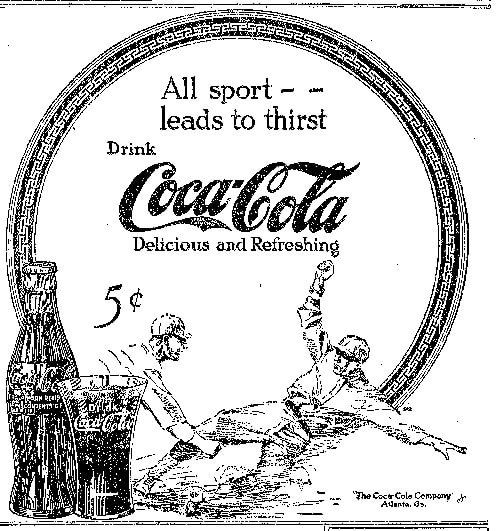
Your great grandparents may not have enjoyed a Coke, but they certainly had the opportunity. Coca Cola began appearing in advertising in the Idaho Statesman in 1896. The drink was invented in 1886 by pharmacist John Pemberton. The beverage’s inventor knew nothing about marketing, so didn’t do especially well with his drink. It was Asa Griggs Candler who took over the company and made it work, first advertising Coca Cola as a patent medicine that would get rid of fatigue and headaches.
And, yes, one early version of Coca Cola did contain a trace of cocaine, which was a common patent medicine ingredient. In 1907, the Idaho Pure Food Commission did an analysis of “the popular soda drink called Coca Cola.” A story in the Statesman said the commission had found no cocaine, but, “While this is not to be classed with as dangerous drug as cocaine, it is not one which can be recommended for constant us. A glass of Coca Cola, as ordinarily served at soda fountains, contains about one grain of caffeine.”
The Women’s Christian Temperance Union wasn’t convinced. A 1908 Idaho Statesman article noted that a WCTU meeting had been about the danger of drinking Coca Cola. “Mrs. McIntyre reading from various sources descriptive of this evil. These articles claim that in spite of the requirements of the new pure food law, this beverage still contains injurious quantities of cocaine.”
The WCTU had better luck, for a time, with prohibition of alcohol. Coca Cola went on to be a somewhat popular drink in Idaho and every other corner of the earth.

Published on September 04, 2020 04:00
September 3, 2020
The Old Bingham County Courthouse
We’ve all had that feeling. The, “wait, it couldn’t have been that long ago” feeling. I get that sense when I drive by Courthouse Square in Blackfoot. It's a nice little park with a fountain that local delinquents enjoy pouring soap into on a regular basis.
But it wasn’t always a park. It was the site of the Bingham County Courthouse (picture), built in 1885. It was remodeled in 1956, which was about the time I would have started riding down Shilling Avenue past it with my mother, the “egg lady,” on her delivery rounds. I started driving past it myself in 1964 when I got my first driver’s license there at age 14.
The two-story building was something of an Italianate style with its bracketed eaves, segmental window arches, and cubical massing, all resting on a lava rock foundation. It served the needs of Bingham County for about a hundred years. The building was demolished in 1987. A new courthouse was built across town.
Shilling Avenue in Blackfoot is named after early pioneer Watson N. Shilling. He was instrumental in securing the authority for the railroad to cross the Fort Hall Indian Reservation in 1878.
This post uses information from a booklet called “The Historic Shilling District” published by the Bingham County Historical Society.
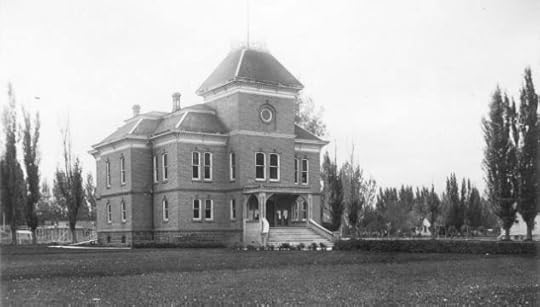
But it wasn’t always a park. It was the site of the Bingham County Courthouse (picture), built in 1885. It was remodeled in 1956, which was about the time I would have started riding down Shilling Avenue past it with my mother, the “egg lady,” on her delivery rounds. I started driving past it myself in 1964 when I got my first driver’s license there at age 14.
The two-story building was something of an Italianate style with its bracketed eaves, segmental window arches, and cubical massing, all resting on a lava rock foundation. It served the needs of Bingham County for about a hundred years. The building was demolished in 1987. A new courthouse was built across town.
Shilling Avenue in Blackfoot is named after early pioneer Watson N. Shilling. He was instrumental in securing the authority for the railroad to cross the Fort Hall Indian Reservation in 1878.
This post uses information from a booklet called “The Historic Shilling District” published by the Bingham County Historical Society.

Published on September 03, 2020 04:00
September 2, 2020
The Taft Pig
President William Howard Taft made headlines all across Idaho in 1911. He made speeches in Moscow, Caldwell, Boise, and Pocatello. It was part of at least a 15-state tour he was making with a focus on the Pacific Northwest.
Dignitaries such as the president of the United States are often given some commemorative trinket by which they are supposed to remember their visit to Anytown, USA. Taft probably did remember the gift he got in Pocatello on October 11.
Edna Maxfield Whited Dubois, boasting an excess of names, was nevertheless referred to as “Mrs. Fred T. Dubois” when the Blackfoot Republican wrote about her gift to the president. Mrs. Dubois knew Taft from spending time in Washington, DC, where Fred served as a senator from Idaho from 1901 to 1907. She had apparently made Taft a promise that he would “taste the products of the Mountain View farm” when he visited. Senator and Mrs. Dubois owned the farm, which was near Moreland which, if you don’t know, is near Blackfoot.
The gift Mrs. Dubois gave to the president was a registered Poland China suckling pig. Now, lest you wonder what a president does with a baby pig while on a sweeping train tour of the Western states, I refer you to her original promise. He ate it. The roasted pig was the main course for the luncheon as the presidential party made its way west that day to Boise. The paper reported that the meal was “thoroughly appreciated.”
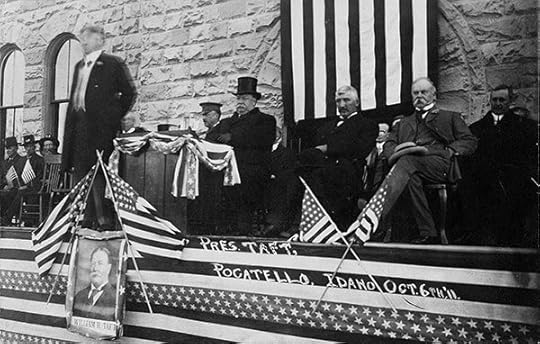 This photo was taken pre-pig on October 11, 1911. President William Howard Taft is seated behind the podium wearing a top hat. Former Governor James H. Brady is standing and speaking in an animated enough way to be little more than a blur. Seated with a bowler hat on his knee was former U.S. Senator Fred T. Dubois, owner of the gifted pig. Photo courtesy of the Idaho Transportation Department digital collection.
This photo was taken pre-pig on October 11, 1911. President William Howard Taft is seated behind the podium wearing a top hat. Former Governor James H. Brady is standing and speaking in an animated enough way to be little more than a blur. Seated with a bowler hat on his knee was former U.S. Senator Fred T. Dubois, owner of the gifted pig. Photo courtesy of the Idaho Transportation Department digital collection.
Dignitaries such as the president of the United States are often given some commemorative trinket by which they are supposed to remember their visit to Anytown, USA. Taft probably did remember the gift he got in Pocatello on October 11.
Edna Maxfield Whited Dubois, boasting an excess of names, was nevertheless referred to as “Mrs. Fred T. Dubois” when the Blackfoot Republican wrote about her gift to the president. Mrs. Dubois knew Taft from spending time in Washington, DC, where Fred served as a senator from Idaho from 1901 to 1907. She had apparently made Taft a promise that he would “taste the products of the Mountain View farm” when he visited. Senator and Mrs. Dubois owned the farm, which was near Moreland which, if you don’t know, is near Blackfoot.
The gift Mrs. Dubois gave to the president was a registered Poland China suckling pig. Now, lest you wonder what a president does with a baby pig while on a sweeping train tour of the Western states, I refer you to her original promise. He ate it. The roasted pig was the main course for the luncheon as the presidential party made its way west that day to Boise. The paper reported that the meal was “thoroughly appreciated.”
 This photo was taken pre-pig on October 11, 1911. President William Howard Taft is seated behind the podium wearing a top hat. Former Governor James H. Brady is standing and speaking in an animated enough way to be little more than a blur. Seated with a bowler hat on his knee was former U.S. Senator Fred T. Dubois, owner of the gifted pig. Photo courtesy of the Idaho Transportation Department digital collection.
This photo was taken pre-pig on October 11, 1911. President William Howard Taft is seated behind the podium wearing a top hat. Former Governor James H. Brady is standing and speaking in an animated enough way to be little more than a blur. Seated with a bowler hat on his knee was former U.S. Senator Fred T. Dubois, owner of the gifted pig. Photo courtesy of the Idaho Transportation Department digital collection.
Published on September 02, 2020 04:00
September 1, 2020
Big Mike
One of the most common locomotive engines during the heyday of steam was the Mikado. It was called the Mikado because many of the first engines were built for export to Japan. Railroad workers nicknamed the Mikados “Mike.” That’s why the one on display at the Boise Depot is called Big Mike.
They were giants. Big Mike is almost 82 feet long, counting its tender. It’s 15 feet 10 3/8 inches from the ground to the top of the stack, and the whole thing weighs 463,000 pounds before it takes on up to 17 tons of coal and 10,000 gallons of water.
They built the 14,000 Mikados from 1911 through 1944. Big Mike is a Mikado 282, which means it has eight big wheels underneath the locomotive with two smaller wheels in front and two in back.
Big Mike, or Engine No. 2295, was retired by Union Pacific and donated to the city of Boise in 1956. The locomotive was subsequently moved to the 3rd Street entrance to Julia Davis Park.
On Dec. 9, 2007, Big Mike—minus its tender—was moved to a new home on a siding east of the Boise Depot. Hundreds of people watched the move, which occurred at midnight on a cold winter's night. The tender, which carried water and fuel for the engine, was separated from the engine and had been moved on Dec. 6, 2007.
It’s well worth visiting the Boise Depot and Big Mike if you haven’t already done so.
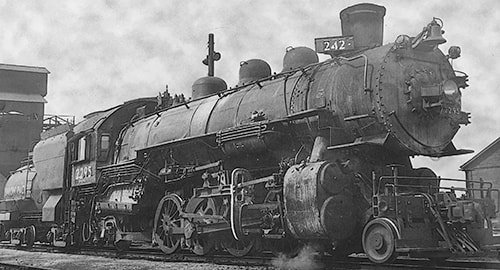
They were giants. Big Mike is almost 82 feet long, counting its tender. It’s 15 feet 10 3/8 inches from the ground to the top of the stack, and the whole thing weighs 463,000 pounds before it takes on up to 17 tons of coal and 10,000 gallons of water.
They built the 14,000 Mikados from 1911 through 1944. Big Mike is a Mikado 282, which means it has eight big wheels underneath the locomotive with two smaller wheels in front and two in back.
Big Mike, or Engine No. 2295, was retired by Union Pacific and donated to the city of Boise in 1956. The locomotive was subsequently moved to the 3rd Street entrance to Julia Davis Park.
On Dec. 9, 2007, Big Mike—minus its tender—was moved to a new home on a siding east of the Boise Depot. Hundreds of people watched the move, which occurred at midnight on a cold winter's night. The tender, which carried water and fuel for the engine, was separated from the engine and had been moved on Dec. 6, 2007.
It’s well worth visiting the Boise Depot and Big Mike if you haven’t already done so.

Published on September 01, 2020 04:00
August 31, 2020
Pop Quiz!
Below is a little Idaho trivia quiz. If you’ve been following Speaking of Idaho, you might do very well. Caution, it is my job to throw you off the scent. Answers below the picture.
1). There is a unique item in Idaho that traces back to Butch Cassiday. What and where is it?
A. A pearl-handled pistol at the Idaho State Museum.
B. The only known photo of the man at the Idaho State Archives.
C. A bank he robbed in Montpelier is now a museum.
D. A Hole in the Wall hideout near Malad City.
E. A rock where he carved “B. Cassidy, 1894,” located at City of Rocks.
2). What was Pearl Royal Hendrickson mining in the Boise foothills?
A. Gallium.
B. Mercury.
C. Silver.
D. Pyrite.
E. Gold.
3). The Leadore charcoal kilns resemble skeps. What’s skep?
A. A loose haystack.
B. A Norwegian hat.
C. A beaver hut.
D. A beehive.
E. A yurt.
4). What was unusual about the Almo Massacre memorialized in stone in the town of Almo?
A. It was the worst loss of life suffered in a wagon train attack.
B. It was the worst loss of life suffered in a raid on an Indian village.
C. Outraged citizens demanded, and got, a military fort to protect future wagon trains.
D. Not a single soul survived.
E. It didn’t happen.
5) What street was named because of the Ada County fairgrounds?
A. Fairbrook Ct
B. Fairbrook Dr
C. Fairhaven LN
D. Fairfield Ave
E. Fairview Ave
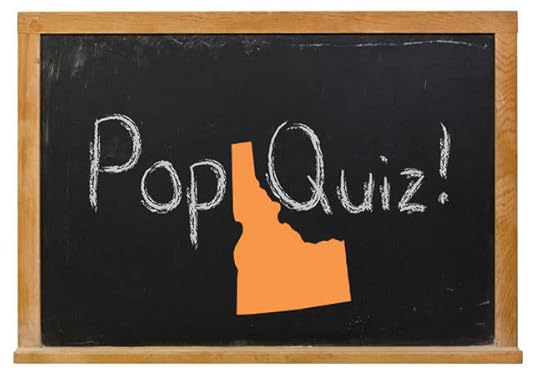 Answers
Answers
1, C
2, A
3, D
4, E
5, E
How did you do?
5 right—Why aren’t you writing this blog?
4 right—A true Idaho native, no matter where you’re from.
3 right—Good! Treat yourself to some French fries.
2 right—Okay! Eat more potatoes!
1 right—Meh. You need to read more blog posts.
0 right—Really, you should reconsider your recent relocation.
1). There is a unique item in Idaho that traces back to Butch Cassiday. What and where is it?
A. A pearl-handled pistol at the Idaho State Museum.
B. The only known photo of the man at the Idaho State Archives.
C. A bank he robbed in Montpelier is now a museum.
D. A Hole in the Wall hideout near Malad City.
E. A rock where he carved “B. Cassidy, 1894,” located at City of Rocks.
2). What was Pearl Royal Hendrickson mining in the Boise foothills?
A. Gallium.
B. Mercury.
C. Silver.
D. Pyrite.
E. Gold.
3). The Leadore charcoal kilns resemble skeps. What’s skep?
A. A loose haystack.
B. A Norwegian hat.
C. A beaver hut.
D. A beehive.
E. A yurt.
4). What was unusual about the Almo Massacre memorialized in stone in the town of Almo?
A. It was the worst loss of life suffered in a wagon train attack.
B. It was the worst loss of life suffered in a raid on an Indian village.
C. Outraged citizens demanded, and got, a military fort to protect future wagon trains.
D. Not a single soul survived.
E. It didn’t happen.
5) What street was named because of the Ada County fairgrounds?
A. Fairbrook Ct
B. Fairbrook Dr
C. Fairhaven LN
D. Fairfield Ave
E. Fairview Ave
 Answers
Answers1, C
2, A
3, D
4, E
5, E
How did you do?
5 right—Why aren’t you writing this blog?
4 right—A true Idaho native, no matter where you’re from.
3 right—Good! Treat yourself to some French fries.
2 right—Okay! Eat more potatoes!
1 right—Meh. You need to read more blog posts.
0 right—Really, you should reconsider your recent relocation.
Published on August 31, 2020 04:00
August 30, 2020
The Massacre Rocks Indian Chief
Traveling the Oregon Trail wasn’t always a one-way trip. Several of those who made the trek came back along the trail years later to reminisce.
Ezra Meeker is probably the best-known Oregon Trail traveler to retrace his journey. He did it several times in order to memorialize the trail’s importance in U.S. history. In his late 70s, 1906-1908, and again from 1910-1912, he travelled the route in a covered wagon and encouraged communities along the way to install memorials to mark the trail. The trail was being obliterated by the passage of time. Without his efforts, we would know much less about that history than we do today. I’ll do an extended post about Meeker in the future.
Today, I want to tell a smaller story that relates only to Idaho, specifically to a single rock. The photo shows the image of an Indian chief scratched onto the surface of a lava rock. It’s a good rendition when you consider that the artist was seven years old. J.J. Hansen was in a wagon train on the Oregon Trail with his parents on their way to Portland, Oregon in 1866 when they stopped at Register Rock. Many travelers carved their names or initials on the big rock, which is a feature of Massacre Rocks State Park today. Young Mr. Hansen found a smaller rock to call his own and proceeded to chip out the image of an Indian and what looks like a cowboy across the rock facing the chief. Hansen called the man in the hat a preacher. He added the year to his artwork, 1866.
Hansen visited the site again in 1908, 42 years later. His youthful artistic leanings had blossomed as an adult and he had become a sculptor. He found the rock on which he had practiced his art and added the new year, 1908, to complete the circle. The latter date is difficult to see in the picture. It is on the lower right.

Ezra Meeker is probably the best-known Oregon Trail traveler to retrace his journey. He did it several times in order to memorialize the trail’s importance in U.S. history. In his late 70s, 1906-1908, and again from 1910-1912, he travelled the route in a covered wagon and encouraged communities along the way to install memorials to mark the trail. The trail was being obliterated by the passage of time. Without his efforts, we would know much less about that history than we do today. I’ll do an extended post about Meeker in the future.
Today, I want to tell a smaller story that relates only to Idaho, specifically to a single rock. The photo shows the image of an Indian chief scratched onto the surface of a lava rock. It’s a good rendition when you consider that the artist was seven years old. J.J. Hansen was in a wagon train on the Oregon Trail with his parents on their way to Portland, Oregon in 1866 when they stopped at Register Rock. Many travelers carved their names or initials on the big rock, which is a feature of Massacre Rocks State Park today. Young Mr. Hansen found a smaller rock to call his own and proceeded to chip out the image of an Indian and what looks like a cowboy across the rock facing the chief. Hansen called the man in the hat a preacher. He added the year to his artwork, 1866.
Hansen visited the site again in 1908, 42 years later. His youthful artistic leanings had blossomed as an adult and he had become a sculptor. He found the rock on which he had practiced his art and added the new year, 1908, to complete the circle. The latter date is difficult to see in the picture. It is on the lower right.

Published on August 30, 2020 04:00



